Land Use and Land Cover Changes and Its Impact on Soil Erosion in Stung Sangkae Catchment of Cambodia
Abstract
:1. Introduction
2. Materials and Methods
2.1. Study Site Description
2.2. Determination of RUSLE Factor Values
2.2.1. Rainfall Erosivity (R) Factor
2.2.2. Soil Erodibility (K) Factor
2.2.3. Topographic (LS) Factor
2.2.4. Crop Management (C) Factor and Conservation Practice (P) Factor
3. Results
3.1. RUSLE Factors
3.2. Impact of LULC Changes on Soil Erosion
3.3. Effect of Elevation and Slope on Soil Erosion
3.4. Contribution of Land Use and Land Cover Changes to Soil Erosion and Its Conversions
4. Discussions
5. Conclusions
Author Contributions
Funding
Institutional Review Board Statement
Informed Consent Statement
Data Availability Statement
Acknowledgments
Conflicts of Interest
References
- Ozsahin, E.; Duru, U.; Eroglu, I. Land Use and Land Cover Changes (LULCC), a key to understand soil erosion intensities in the Maritsa Basin. Water 2018, 10, 335. [Google Scholar] [CrossRef] [Green Version]
- Pimentel, D.; Burgess, M. Soil erosion threatens food production. Agriculture 2013, 3, 443–463. [Google Scholar] [CrossRef] [Green Version]
- Chuenchum, P.; Xu, M.; Tang, W. Estimation of soil erosion and sediment yield in the Lancang–Mekong River using the modified revised universal soil loss equation and GIS techniques. Water 2019, 12, 135. [Google Scholar] [CrossRef] [Green Version]
- Benavidez, R.; Jackson, B.; Maxwell, D.; Norton, K. A review of the (Revised) Universal Soil Loss Equation ((R)USLE): With a view to increasing its global applicability and improving soil loss estimates. Hydrol. Earth Syst. Sci. 2018, 22, 6059–6086. [Google Scholar] [CrossRef] [Green Version]
- Borrelli, P.; Robinson, D.A.; Panagos, P.; Lugato, E.; Yang, J.E.; Alewell, C.; Wuepper, D.; Montanarella, L.; Ballabio, C. Land use and climate change impacts on global soil erosion by water (2015–2070). Proc. Natl. Acad. Sci. USA 2020, 117, 21994–22001. [Google Scholar] [CrossRef] [PubMed]
- Mihara, M.; Yamamoto, N.; Ueno, T. Application of USLE for the prediction of nutrient losses in soil erosion processes. Paddy Water Environ. 2005, 3, 111–119. [Google Scholar] [CrossRef]
- Pham, T.G.; Degener, J.; Kappas, M. Integrated Universal Soil Loss Equation (USLE) and Geographical Information System (GIS) for soil erosion estimation in A Sap Basin: Central Vietnam. Int. Soil Water Conserv. Res. 2018, 6, 99–110. [Google Scholar] [CrossRef]
- Bonilla, C.A.; Reyes, J.L.; Magri, A. Water erosion prediction using the Revised Universal Soil Loss Equation (RUSLE) in a GIS framework, Central Chile. Chil. J. Agric. Res. 2010, 70, 159–169. [Google Scholar] [CrossRef] [Green Version]
- Marondedze, A.K.; Schütt, B. Assessment of soil erosion using the RUSLE model for the Epworth district of the Harare Metropolitan province, Zimbabwe. Sustainability 2020, 12, 8531. [Google Scholar] [CrossRef]
- Ashiagbor, G.; Forkuo, E.K.; Laari, P.; Aabeyir, R. Modeling soil erosion using RUSLE and GIS tools. Int. J. Remote Sens. Geosci. 2013, 2, 17. [Google Scholar]
- Van Oost, K.; Quine, T.A.; Govers, G.; De Gryze, S.; Six, J.; Harden, J.W.; Ritchie, J.C.; McCarty, G.W.; Heckrath, G.; Kosmas, C.; et al. The impact of agricultural soil erosion on the global carbon cycle. Science 2007, 318, 626–629. [Google Scholar] [CrossRef]
- Wilkinson, B.H.; McElroy, B.J. The impact of humans on continental erosion and sedimentation. Geol. Soc. Am. Bull. 2007, 119, 140–156. [Google Scholar] [CrossRef]
- Tang, W.; Shan, B.; Zhang, H.; Zhang, W.; Zhao, Y.; Ding, Y.; Rong, N.; Zhu, X. Heavy metal contamination in the surface sediments of representative limnetic ecosystems in Eastern China. Sci. Rep. 2014, 4, 7152. [Google Scholar] [CrossRef] [Green Version]
- Panagopoulos, Y.; Dimitriou, E.; Skoulikidis, N. Vulnerability of a northeast Mediterranean island to soil loss. can crazing management mitigate erosion? Water 2019, 11, 1491. [Google Scholar] [CrossRef] [Green Version]
- Kogo, B.K.; Kumar, L.; Koech, R. Impact of land use/cover changes on soil erosion in western Kenya. Sustainability 2020, 12, 9740. [Google Scholar] [CrossRef]
- Chen, T.; Niu, R.; Li, P.; Zhang, L.; Du, B. Regional soil erosion risk mapping using RUSLE, GIS, and remote sensing: A case study in Miyun watershed, north China. Environ. Earth Sci. 2011, 63, 533–541. [Google Scholar] [CrossRef]
- Evans, R. An alternative way to assess water erosion of cultivated land—field-based measurements and analysis of some results. Appl. Geogr. 2002, 22, 187–207. [Google Scholar] [CrossRef]
- Evans, R.; Brazier, R. Evaluation of modelled spatially distributed predictions of soil erosion by water versus field-based assessments. Environ. Sci. Policy 2005, 8, 493–501. [Google Scholar] [CrossRef] [Green Version]
- Renschler, C.S.; Harbor, J. Soil erosion assessment tools from point to regional scales—the role of geomorphologists in land management research and implementation. Geomorphology 2002, 47, 189–209. [Google Scholar] [CrossRef]
- Renard, K.G.; Foster, G.R.; Weesies, G.A.; McCool, D.K.; Yoder, D.C. Predicting Soil Erosion by Water: A Guide to Conservation Planning with the Revised Universal Soil Loss Equation (RUSLE); Agriculture Handbook No. 703; USDA-ARS: Washington, DC, USA, 1997; p. 404.
- Karydas, C.G.; Panagos, P.; Gitas, I.Z. A classification of water erosion models according to their geospatial characteristics. Int. J. Digit. Earth 2014, 7, 229–250. [Google Scholar] [CrossRef]
- Gashaw, T.; Tulu, T.; Argaw, M.; Worqlul, A.W. Modeling the impacts of land use–land cover changes on soil erosion and sediment yield in the Andassa watershed, upper Blue Nile Basin, Ethiopia. Environ. Earth Sci. 2019, 78, 679. [Google Scholar] [CrossRef]
- Mustefa, M.; Fufa, F.; Takala, W. GIS estimation of annual average soil loss rate from Hangar River watershed using RUSLE. J. Water Clim. Chang. 2020, 11, 529–539. [Google Scholar] [CrossRef] [Green Version]
- Kidane, M.; Bezie, A.; Kesete, N.; Tolessa, T. The impact of Land Use and Land Cover (LULC) dynamics on soil erosion and sediment yield in Ethiopia. Heliyon 2019, 5, e02981. [Google Scholar] [CrossRef] [PubMed] [Green Version]
- Gelagay, H.S.; Minale, A.S. Soil loss estimation using GIS and remote sensing techniques: A case of Koga watershed, northwestern Ethiopia. Int. Soil Water Conserv. Res. 2016, 4, 126–136. [Google Scholar] [CrossRef] [Green Version]
- Tadesse, L.; Suryabhagavan, K.V.; Sridhar, G.; Legesse, G. Land use and land cover changes and soil erosion in Yezat watershed, north western Ethiopia. Int. Soil Water Conserv. Res. 2017, 5, 85–94. [Google Scholar] [CrossRef] [Green Version]
- Balabathina, V.N.; Raju, R.P.; Mulualem, W.; Tadele, G. Estimation of soil loss using remote sensing and GIS-based universal soil loss equation in northern catchment of lake Tana sub-basin, upper Blue Nile Basin, northwest Ethiopia. Environ. Syst. Res. 2020, 9, 35. [Google Scholar] [CrossRef]
- Ayele, N.A.; Naqvi, H.R.; Alemayehu, D. Rainfall induced soil erosion assessment, prioritization and conservation treatment using RUSLE and SYI models in Highland watershed of Ethiopia. Geocarto Int. 2020, 35, 1–17. [Google Scholar] [CrossRef]
- Hui, L.; Xiaoling, C.; Lim, K.J.; Xiaobin, C.; Sagong, M. Assessment of soil erosion and sediment yield in Liao watershed, Jiangxi province, China, using USLE, GIS, and RS. J. Earth Sci. 2010, 21, 941–953. [Google Scholar] [CrossRef]
- Prasannakumar, V.; Vijith, H.; Abinod, S.; Geetha, N. Estimation of soil erosion risk within a small Mountainous sub-watershed in Kerala, India, using Revised Universal Soil Loss Equation (RUSLE) and geo-information technology. Geosci. Front. 2012, 3, 209–215. [Google Scholar] [CrossRef] [Green Version]
- Javed, A.; Tanzeel, K.; Aleem, M. Estimation of sediment yield of Govindsagar catchment, Lalitpur district, (U.P.), India, using remote sensing and GIS techniques. JGIS 2016, 8, 595–607. [Google Scholar] [CrossRef] [Green Version]
- Kolli, M.K.; Opp, C.; Groll, M. Estimation of soil erosion and sediment yield concentration across the Kolleru Lake catchment using GIS. Environ. Earth Sci. 2021, 80, 161. [Google Scholar] [CrossRef]
- Talchabhadel, R.; Nakagawa, H.; Kawaike, K.; Prajapati, R. Evaluating the rainfall erosivity (R-Factor) from daily rainfall data: An application for assessing climate change impact on soil loss in Westrapti River Basin, Nepal. Model. Earth Syst. Environ. 2020, 6, 1741–1762. [Google Scholar] [CrossRef]
- Koirala, P.; Thakuri, S.; Joshi, S.; Chauhan, R. Estimation of soile erosion in Nepal using a RUSLE modeling and geospatial tool. Geosciences 2019, 9, 147. [Google Scholar] [CrossRef] [Green Version]
- Thuy, H.T.; Lee, G. Soil loss vulnerability assessment in the Mekong River Basin. J. Korean Geo-Environ. Soc. 2017, 18, 37–47. [Google Scholar] [CrossRef]
- Plangoen, P.; Babel, M.; Clemente, R.; Shrestha, S.; Tripathi, N. Simulating the impact of future land use and climate change on soil erosion and deposition in the Mae Nam Nan sub-catchment, Thailand. Sustainability 2013, 5, 3244–3274. [Google Scholar] [CrossRef] [Green Version]
- Chuenchum, P.; Xu, M.; Tang, W. Predicted trends of soil erosion and sediment yield from future land use and climate change scenarios in the Lancang–Mekong River by using the modified RUSLE model. Int. Soil Water Conserv. Res. 2020, 8, 213–227. [Google Scholar] [CrossRef]
- Merritt, W.S.; Letcher, R.A.; Jakeman, A.J. A review of erosion and sediment transport models. Environ. Model. Softw. 2003, 18, 761–799. [Google Scholar] [CrossRef]
- Raza, A.; Ahrends, H.; Habib-Ur-Rahman, M.; Gaiser, T. Modeling approaches to assess soil erosion by water at the field scale with special emphasis on heterogeneity of soils and crops. Land 2021, 10, 422. [Google Scholar] [CrossRef]
- Wischmeier, W.H.; Smith, D.D. Predicting Rainfall Erosion Losses: A Guide to Conservation Planning; Department of Agriculture, Science and Education Administration: Washington, DC, USA, 1978.
- Williams, J.R.; Berndt, H.D. Sediment yield prediction bsed on watershed hydrology. Trans. ASAE 1977, 20, 1100–1104. [Google Scholar] [CrossRef]
- Stefanidis, S.; Alexandridis, V.; Chatzichristaki, C.; Stefanidis, P. Assessing soil loss by water erosion in a typical Mediterranean ecosystem of northern Greece under current and future rainfall erosivity. Water 2021, 13, 2002. [Google Scholar] [CrossRef]
- Alewell, C.; Borrelli, P.; Meusburger, K.; Panagos, P. Using the USLE: Chances, challenges and limitations of Ssil erosion modelling. Int. Soil Water Conserv. Res. 2019, 7, 203–225. [Google Scholar] [CrossRef]
- Williams, J.R.; Arnold, J.G.; Srinivasan, R.; Ramanarayanan, T.S. APEX: A New Tool for Predicting the Effects of Climate and CO2 Changes on Erosion and Water Quality. In Modelling Soil Erosion by Water; Boardman, J., Favis-Mortlock, D., Eds.; Springer: Berlin/Heidelberg, Germany, 1998; pp. 441–449. ISBN 978-3-642-63787-2. [Google Scholar]
- Arnold, J.G.; Srinivasan, R.; Muttiah, R.S.; Williams, J.R. Large area hydrologic modelling and assessment part I: Model development. J. Am. Water Resour. Assoc. 1998, 34, 73–89. [Google Scholar] [CrossRef]
- Beck, M.B. Water quality modeling: A review of the analysis of uncertainty. Water Resour. Res. 1987, 23, 1393–1442. [Google Scholar] [CrossRef] [Green Version]
- Williams, J.R.; Jones, C.A.; Kiniry, J.R.; Spanel, D.A. The EPIC crop growth model. Trans. ASAE 1989, 32, 0497–0511. [Google Scholar] [CrossRef]
- Laflen, J.M.; Lane, L.J.; Foster, G.R. WEPP: A new generation of erosion prediction technology. J. Soil Water Conserv. 1991, 34–38. [Google Scholar]
- Reyes, M.R.; Raczkowski, C.W.; Gayle, G.A.; Reddy, G.B. Comparing the soil loss predictions of GLEAMS, RUSLE, EPIC, and WEPP. Trans. ASAE 2004, 47, 489–493. [Google Scholar] [CrossRef]
- Saleh, A.; Gallego, O. Application of SWAT and APEX using the SWAPP (SWAT-APEX) program for the upper north Bosque River watershed in Texas. Trans. ASABE 2007, 50, 1177–1187. [Google Scholar] [CrossRef]
- Reyes, M.R.; Bengtson, R.L.; Robbins, K.D. RIP and WMRIP: New measures of rainfall instensity distribution. Trans. ASAE 1992, 36, 1619–1623. [Google Scholar] [CrossRef]
- Bezak, N.; Ballabio, C.; Mikoš, M.; Petan, S.; Borrelli, P.; Panagos, P. Reconstruction of past rainfall erosivity and trend detection based on the REDES database and reanalysis rainfall. J. Hydrol. 2020, 590, 125372. [Google Scholar] [CrossRef]
- Panagos, P.; Ballabio, C.; Meusburger, K.; Spinoni, J.; Alewell, C.; Borrelli, P. Towards estimates of future rainfall erosivity in Europe based on REDES and WorldClim datasets. J. Hydrol. 2017, 548, 251–262. [Google Scholar] [CrossRef] [PubMed]
- Wischmeier, W.H.; Smith, D.D. Rainfall energy and its relationship to soil loss. Trans. AGU 1958, 39, 285. [Google Scholar] [CrossRef]
- Hateffard, F.; Mohammed, S.; Alsafadi, K.; Enaruvbe, G.O.; Heidari, A.; Abdo, H.G.; Rodrigo-Comino, J. CMIP5 climate projections and RUSLE-based soil erosion assessment in the central part of Iran. Sci. Rep. 2021, 11, 1–17. [Google Scholar] [CrossRef]
- Stefanidis, S.; Chatzichristaki, C. Response of soil erosion in a mountainous catchment to temperature and trecipitation trends. Carpathian J. Earth Environ. Sci. 2017, 12, 35–39. [Google Scholar]
- Sok, T.; Oeurng, C.; Ich, I.; Sauvage, S.; Miguel Sánchez-Pérez, J. Assessment of hydrology and sediment yield in the Mekong River Basin using SWAT model. Water 2020, 12, 3503. [Google Scholar] [CrossRef]
- Fox, J. Understanding a dynamic landscape: Land use, land cover, and resource tenure in northeastern Cambodia. Link. People Place Policy 2002, 113–130. [Google Scholar] [CrossRef]
- FAO. Assessment of Land Use, Forest Policy and Governance in Cambodia; Food and Agriculture Organization: Rome, Italy, 2010. [Google Scholar]
- Mekong River Comission (MRC). Land Cover Map of the Lower Mekong Basin; Information and Knowledge Management Programme; Mekong River Commission: Phnom Penh, Cambodia, 2016. [Google Scholar]
- Kityuttachai, K.; Heng, S.; Sou, V. Land Cover Information Catalogue of the Lower Mekong Basin; MRC Technical Paper No. 58. Technical Report from Mekong River Commision. In Proceedings of the Information and Knowledge Management Programme, Mekong River Commission, Phnom Penh, Cambodia, 2016; p. 83. Available online: http://archive.iwlearn.net/mrcmekong.org/programmes/info_management.htm (accessed on 20 June 2020).
- Ministry of Environment (MoE). Cambodia Forest Cover 2016; Ministry of Environment: Phnom Penh, Cambodia, 2018; p. 23.
- Lohani, S.; Dilts, T.; Weisberg, P.; Null, S.; Hogan, Z. Rapidly accelerating deforestation in Cambodia’s Mekong River Basin: A comparative analysis of spatial patterns and drivers. Water 2020, 12, 2191. [Google Scholar] [CrossRef]
- Nalin, S.; Mony, K.; Hazarika, M.K.; Samarakoon, L. Land cover/land use change detection in Tonle Sap watershed, Cambodia. In Proceedings of the Asian Conference on Remote Sensing, Hanoi, Vietnam, 1–5 November 2010. [Google Scholar]
- Kong, R.; Diepart, J.-C.; Castella, J.-C.; Lestrelin, G.; Tivet, F.; Belmain, E.; Bégué, A. Understanding the drivers of deforestation and agricultural transformations in the northwestern uplands of Cambodia. Appl. Geogr. 2019, 102, 84–98. [Google Scholar] [CrossRef] [Green Version]
- Ministry of Agriculture, Forestry and Fisheries (MAFF). Land Degradation Neutrality Targets; Ministry of Agriculture, Forestry and Fisheries: Phnom Penh, Cambodia, 2018; p. 1.
- Mekong River Comission (MRC). Overvies of Hydrology of the Mekong Basin; Mekong River Comission: Vientiane, Laos, 2005; p. 73. [Google Scholar]
- Food and Agriculture Organization of the United Nations. Guidelines for Soil Description, 4th ed.; Food and Agriculture Organization of the United Nations: Rome, Italy, 2006; ISBN 978-92-5-105521-2. [Google Scholar]
- Japan International Cooperation Agency (JICA). The Study on the Establishment of GIS Base Data of the Kingdom of Cambodia; Japan International Cooperation Agency (JICA): Phnom Penh, Cambodia, 2003; p. 120.
- McCool, M.; Foster, G.; Renard, K.G.; Yoder, D.; Weesies, G. The revised universal soil loss equation. In Proceedings of the Department of Defense/Interagency workshop on Technologies to address soil erosion on Department of Defense Lands, San Antonio, TX, USA, 11–15 June 1995; pp. 195–202. [Google Scholar]
- Kebede, B.; Tsunekawa, A.; Haregeweyn, N.; Adgo, E.; Ebabu, K.; Meshesha, D.T.; Tsubo, M.; Masunaga, T.; Fenta, A.A. Determining C- and P-factors of RUSLE for different land uses and management practices across agro-ecologies: Case studies from the upper Blue Nile Basin, Ethiopia. Phys. Geogr. 2021, 42, 160–182. [Google Scholar] [CrossRef]
- Jayasinghe, P.K.S.C.; Adornado, H.A.; Yoshida, M.; Leelamanie, D.A.L. A web-based GIS and remote sensing framework for Spatial Information System (SIS): A case study in Nuwaraeliya, Sri Lanka. Agric. Inf. Res. 2010, 19, 106–116. [Google Scholar] [CrossRef] [Green Version]
- Adornado, H.A.; Yoshida, M.; Apolinares, H.A. Erosion vulnerability assessment in REINA, Quezon province, Philippines with raster-based tool built within GIS environment. Agric. Inf. Res. 2009, 18, 24–31. [Google Scholar] [CrossRef] [Green Version]
- De Asis, A.M.; Omasa, K. Estimation of vegetation parameter for modeling soil erosion using linear spectral mixture analysis of Landsat ETM data. ISPRS J. Photogramm. Remote Sens. 2007, 62, 309–324. [Google Scholar] [CrossRef]
- Hernandez, E.C.; Henderson, A.; Oliver, D.P. Effects of changing land Uue in the Pagsanjan–Lumban catchment on suspended sediment loads to Laguna de Bay, Philippines. Agric. Water Manag. 2012, 106, 8–16. [Google Scholar] [CrossRef]
- Krishna Bahadur, K.C. Mapping soil erosion susceptibility using remote sensing and GIS: A case of the upper Nam Wa watershed, Nan province, Thailand. Environ. Geol. 2009, 57, 695–705. [Google Scholar] [CrossRef]
- Merritt, W.S.; Croke, B.F.W.; Jakeman, A.J.; Letcher, R.A.; Perez, P. A biophysical toolbox for assessment and management of land and water resources in rural catchments in northern Thailand. Ecol. Model. 2004, 171, 279–300. [Google Scholar] [CrossRef]
- FAO; IIASA; ISRIC; ISS-CAS; JRC. Harmonized World Soil Database (Version 1.2); FAO: Rome, Italy; IIASA: Laxenburg, Austria, 2012; Available online: http://www.fao.org/soils-portal/data-hub/soil-maps-and-databases (accessed on 20 June 2020).
- USGS (United States Geologic Service). Shuttle Radar Topography Mission (SRTM) 1 Arc-Second Global Data. Available online: https://earthexplorer.usgs.gov/SRTM1Arc (accessed on 10 December 2018).
- Morgan, R.P.C. Soil Erosion and Conservation, 3rd ed.; Blackwell Pub.: Malden, MA, USA, 2005; ISBN 978-1-4051-1781-4. [Google Scholar]
- Yang, D.; Kanae, S.; Oki, T.; Koike, T.; Musiake, K. Global potential soil erosion with reference to land use and climate changes. Hydrol. Process. 2003, 17, 2913–2928. [Google Scholar] [CrossRef]
- David, W.P. Soil and water conservation planning: Policy issues and recommendations. Philipp. J. Dev. 1988, 15, 47–84. [Google Scholar]
- Blanco-Canqui, H.; Lal, R. Principles of Soil Conservation and Management; Springer: Dordrecht, The Netherlands, 2008; ISBN 978-90-481-8529-0. [Google Scholar]
- El-Swaify, S.A.; Gramier, C.L.; Lo, A. Recent Advances in Soil Conservation in Steepland in Humid Tropics. In Proceedings of the International Conference on Steepland Agriculture in the Humid Tropics, Kuala Lumpur, Malaysia, 17–21 August 1987; MARDI: Kuala Lumpur, Malasia, 1987; pp. 87–100. [Google Scholar]
- Eiumnoh, A. Integration of Geographic Information Systems (GIS) and Satellite Remote Sensing (SRS) for Watershed Management; Food and Fertilizer Technology Center: Pathumthani, Thailand, 2000. [Google Scholar]
- Byizigiro, R.V.; Rwanyiziri, G.; Mugabowindekwe, M.; Kagoyire, C.; Biryabarema, M. Estimation of soil erosion using RUSLE model and GIS: The case of Satinskyi catchment, western Rwanda. RJESTE 2020, 3, 14–33. [Google Scholar] [CrossRef]
- Moore, I.D.; Burch, G.J. Physical basis of the length-slope factor in the universal soil loss equation. Soil Sci. Soc. Am. J. 1986, 50, 1294–1298. [Google Scholar] [CrossRef]
- Zhang, H.; Yang, Q.; Li, R.; Liu, Q.; Moore, D.; He, P.; Ritsema, C.J.; Geissen, V. Extension of a GIS procedure for calculating the RUSLE equation LS factor. Comput. Geosci. 2013, 52, 177–188. [Google Scholar] [CrossRef]
- Van Remortel, R.D.; Hamilton, M.E.; Hickey, R.J. Estimating the LS factor for RUSLE through iterative slope length processing of digital elevation data within Arclnfo grid. Cartography 2001, 30, 27–35. [Google Scholar] [CrossRef]
- Nakil, M.; Khire, M. Effect of slope steepness parameter computations on soil loss estimation: Review of methods using GIS. Geocarto Int. 2016, 31, 1078–1093. [Google Scholar] [CrossRef]
- Rozos, D.; Skilodimou, H.D.; Loupasakis, C.; Bathrellos, G.D. Application of the revised universal soil loss equation model on landslide prevention. an example from N. Euboea (Evia) island, Greece. Environ. Earth Sci. 2013, 70, 3255–3266. [Google Scholar] [CrossRef]
- Yoshino, K.; Ishioka, Y. Guidelines for soil conservation towards integrated basin management for sustainable development: A new approach based on the assessment of soil loss risk using remote sensing and GIS. Paddy Water Environ. 2005, 3, 235–247. [Google Scholar] [CrossRef]
- McCool, D.K.; Foster, G.R.; Mutchler, C.K.; Meyer, L.D. Revised slope length factor for the universal soil loss equation. Trans. ASAE 1989, 32, 1571–1576. [Google Scholar] [CrossRef]
- Morgan, R.P.C. Soil Erosion and Conservation; Wiley: Hoboken, NJ, USA, 2009; ISBN 978-1-4051-4467-4. [Google Scholar]
- Williams, J.R. The EPIC Model. In Computer Models of Watershed Hydrology; Singh, V.P., Ed.; Water Resources Publications: Highlands Ranch, CO, USA, 1995; ISBN 0-918334-91-8. [Google Scholar]
- Yang, X.; Gao, W.; Shi, Q.; Chen, F.; Chu, Q. Impact of climate change on the water requirement of summer maize in the Huang-Huai-Hai farming region. Agric. Water Manag. 2013, 124, 20–27. [Google Scholar] [CrossRef]
- Thoeun, H.C. Observed and projected changes in temperature and rainfall in Cambodia. Weather Clim. Extrem. 2015, 7, 61–71. [Google Scholar] [CrossRef] [Green Version]
- Lufafa, A.; Tenywa, M.M.; Isabirye, M.; Majaliwa, M.J.G.; Woomer, P.L. Prediction of soil erosion in a Lake Victoria Basin catchment using a GIS-based universal soil loss model. Agric. Syst. 2003, 76, 883–894. [Google Scholar] [CrossRef]
- Bamutaze, Y. Revisiting socio-ecological resilience and sustainability in the coupled mountain landscapes in eastern Africa. Curr. Opin. Environ. Sustain. 2015, 14, 257–265. [Google Scholar] [CrossRef]
- Hudson, N.W. Soil Conservation, 3rd ed.; Batsford: London, UK, 1995. [Google Scholar]
- Rangsiwanichpong, P.; Kazama, S.; Gunawardhana, L. Assessment of sediment yield in Thailand using revised universal soil loss equation and geographic information system techniques: Assessment of sediment yield in Thailand using geographic information system technique. River Res. Appl. 2018, 34, 1113–1122. [Google Scholar] [CrossRef]
- Borrelli, P.; Robinson, D.A.; Fleischer, L.R.; Lugato, E.; Ballabio, C.; Alewell, C.; Meusburger, K.; Modugno, S.; Schütt, B.; Ferro, V.; et al. An assessment of the global impact of 21st century land use change on soil erosion. Nat. Commun. 2017, 8, 2013. [Google Scholar] [CrossRef] [Green Version]
- Sanchez, P.A.; Palm, C.A.; Buol, S.W. Fertility capability soil classification: A tool to help assess soil quality in the tropics. Geoderma 2003, 114, 157–185. [Google Scholar] [CrossRef]
- Khosrokhani, M.; Pradhan, B. Spatio-temporal assessment of soil erosion at Kuala Lumpur Metropolitan city using remote sensing data and GIS. Geomat. Nat. Hazards Risk 2014, 5, 252–270. [Google Scholar] [CrossRef] [Green Version]
- Barbera, V.; Poma, I.; Gristina, L.; Novara, A.; Egli, M. Long-term cropping systems and tillage management effects on soil organic carbon stock and steady state level of C sequestration rates in a semiarid environment. Land Degrad. Dev. 2012, 23, 82–91. [Google Scholar] [CrossRef] [Green Version]

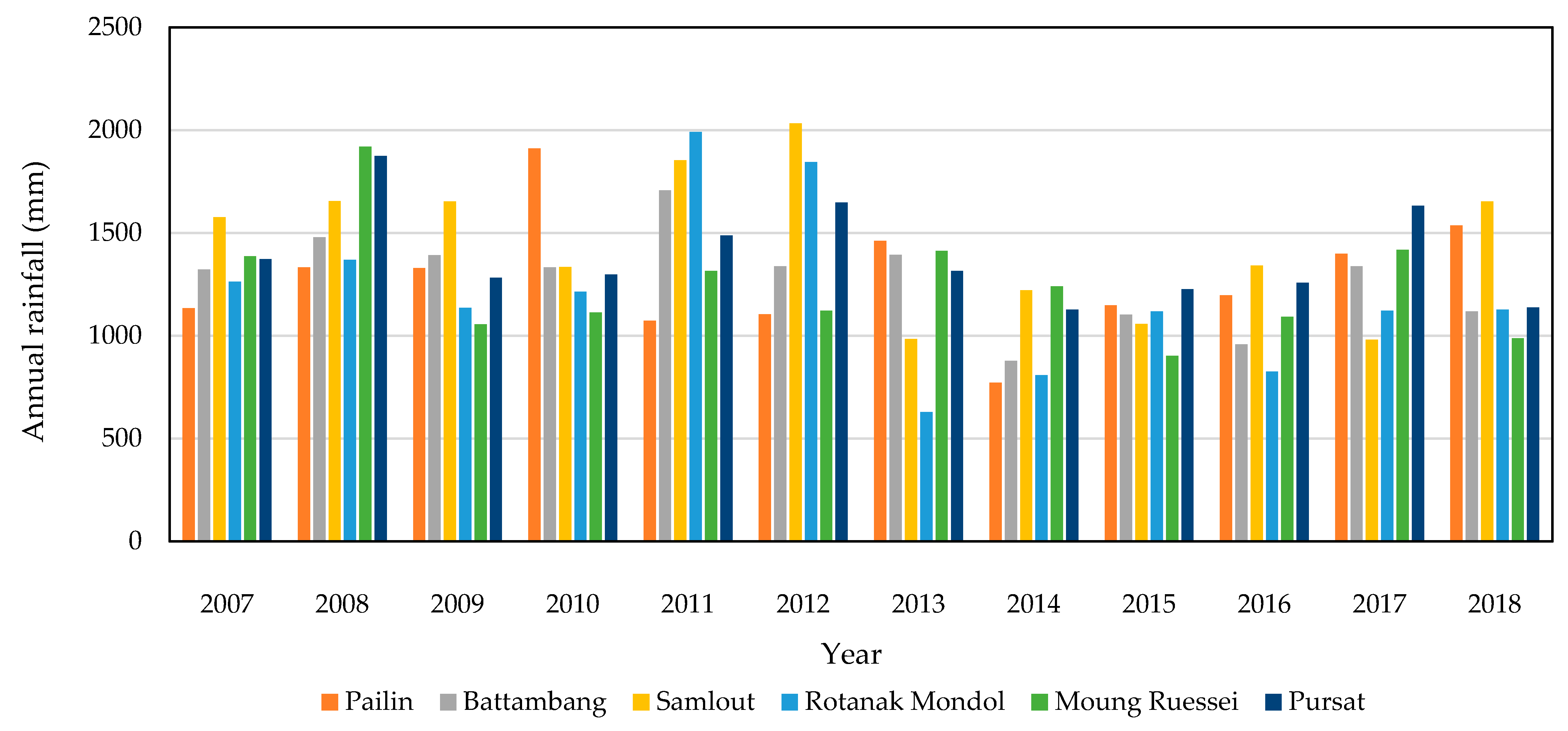
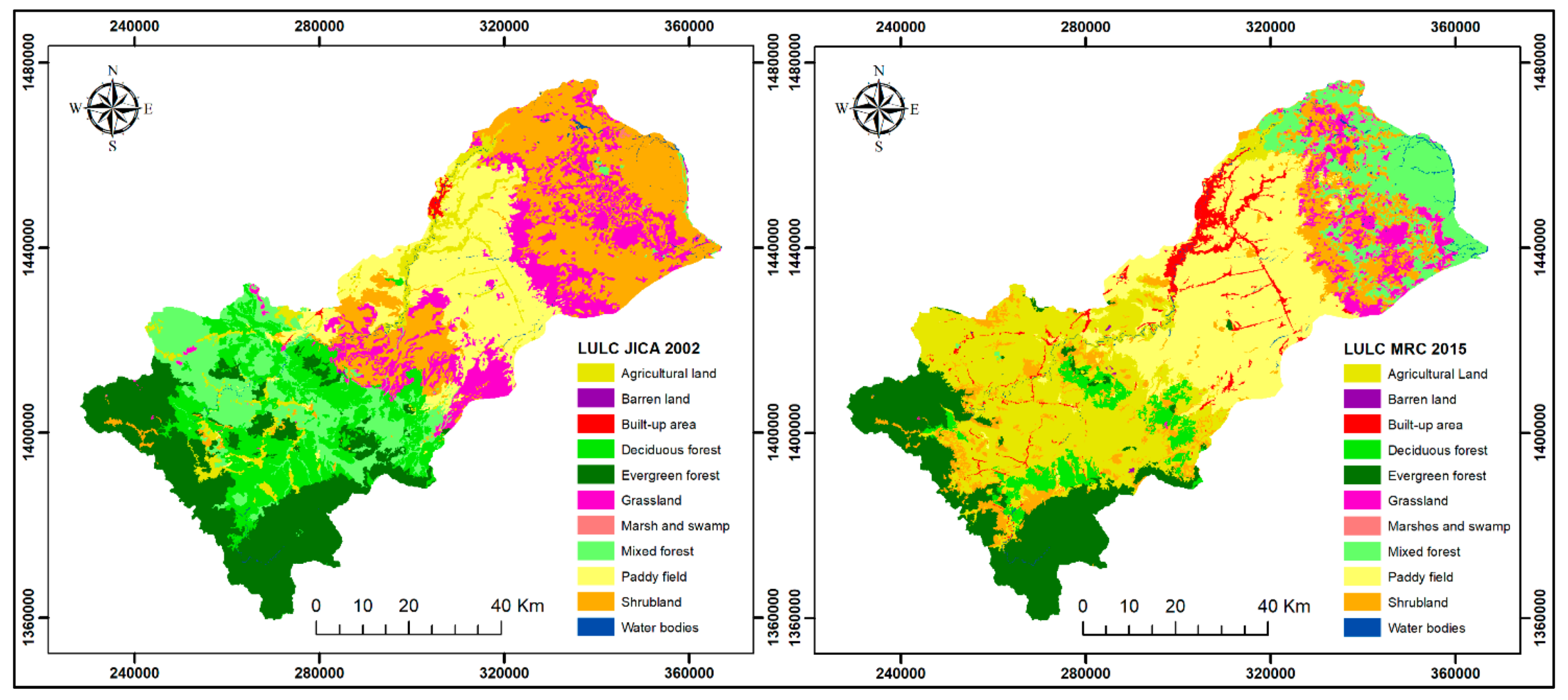

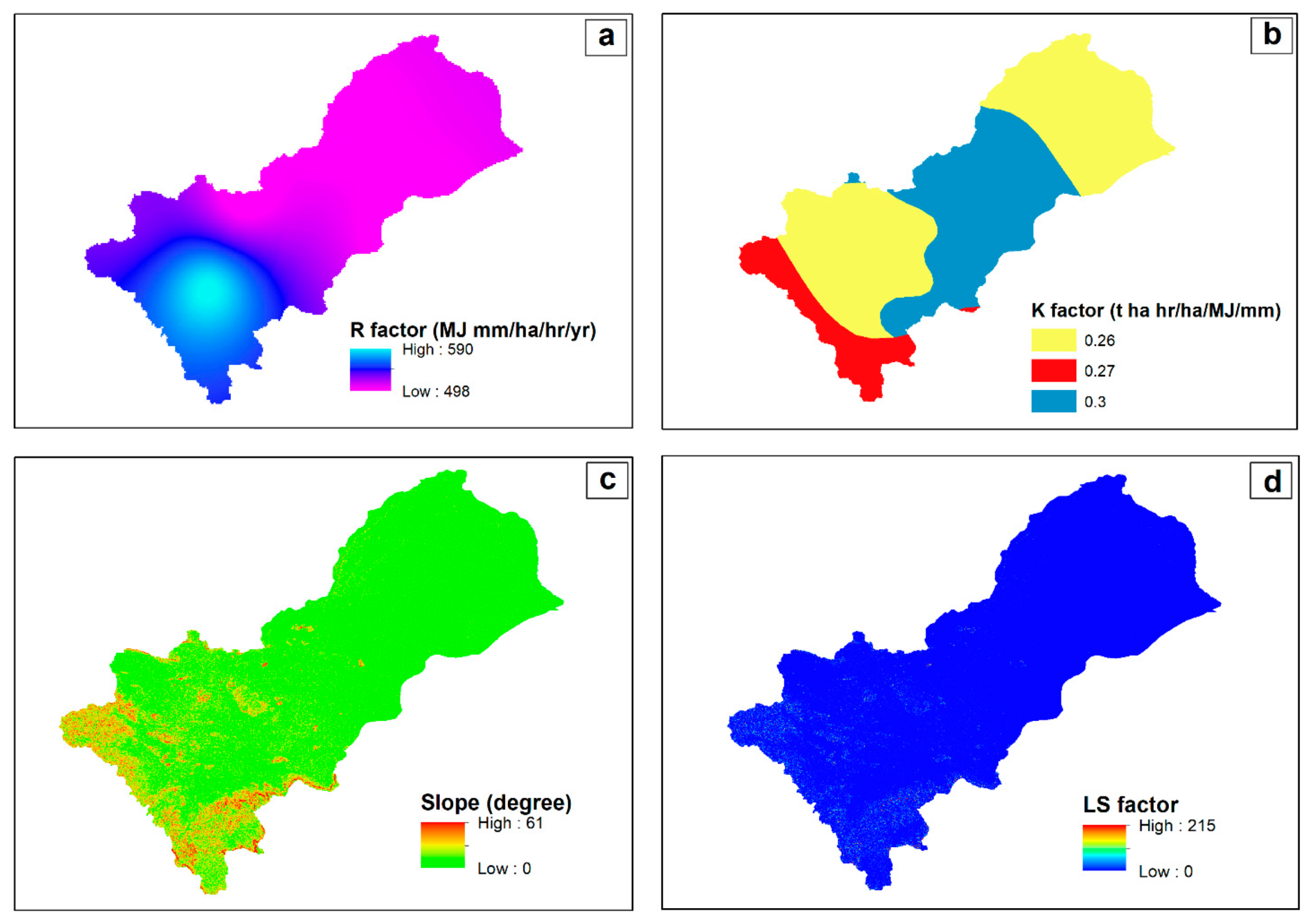
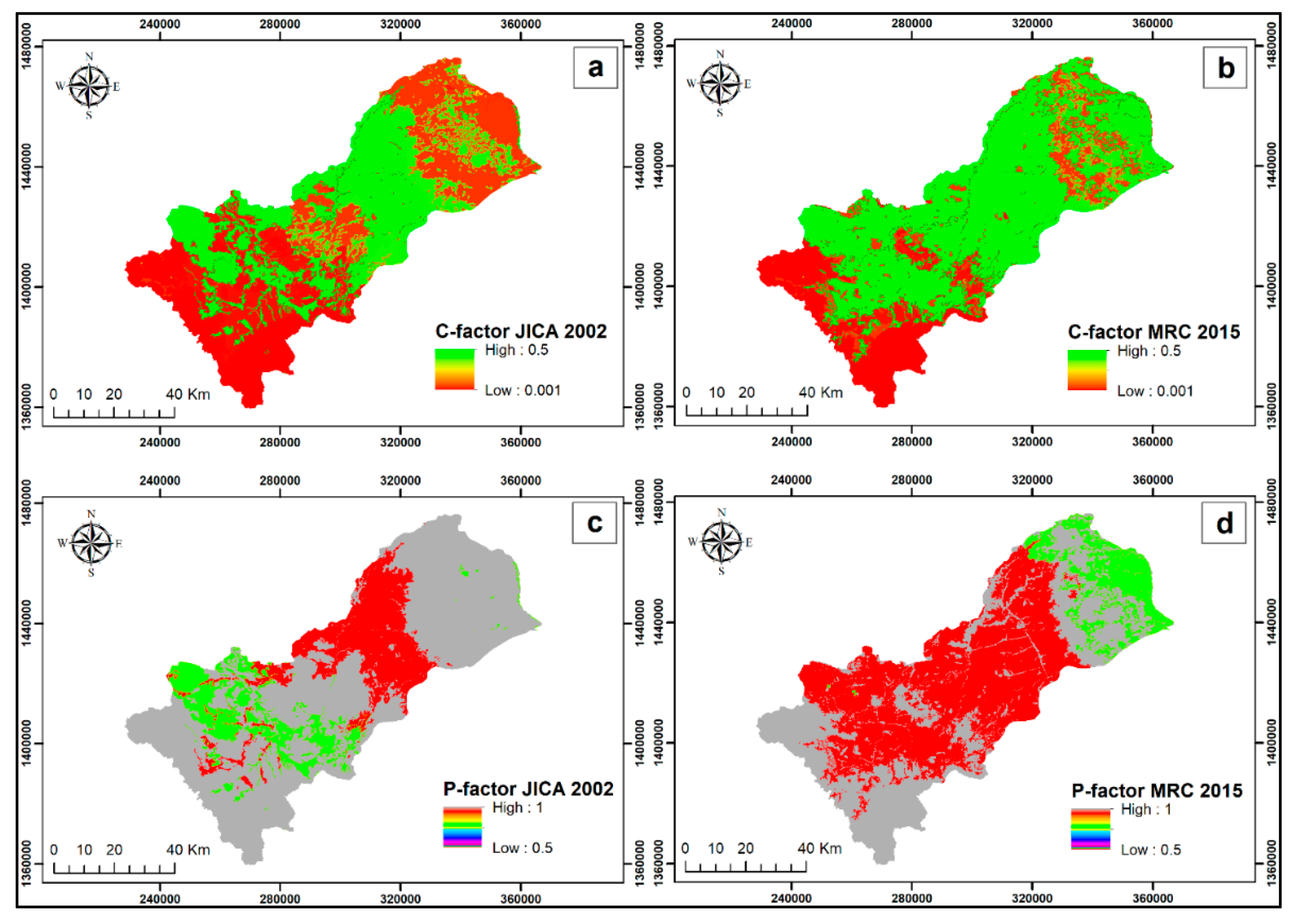

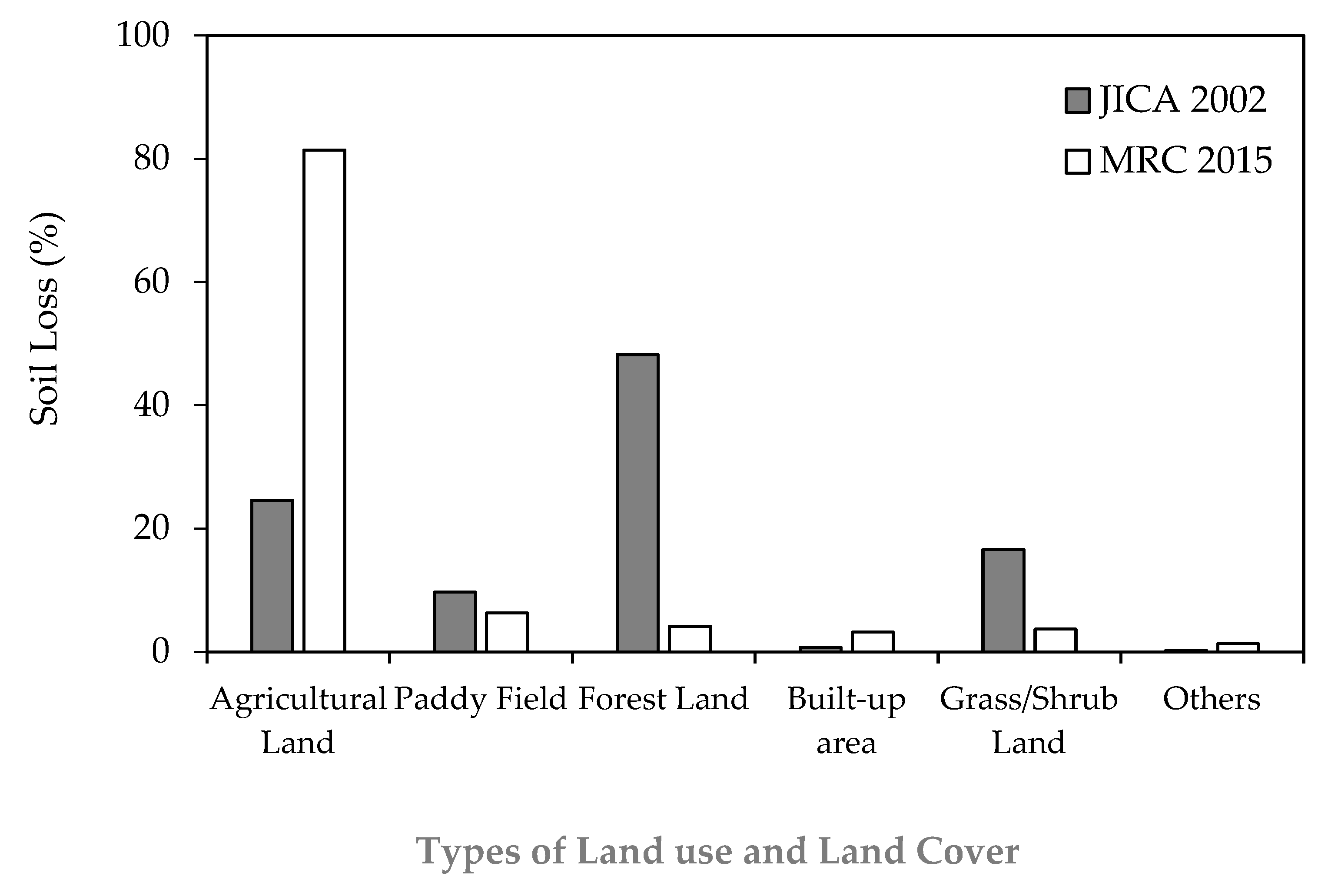
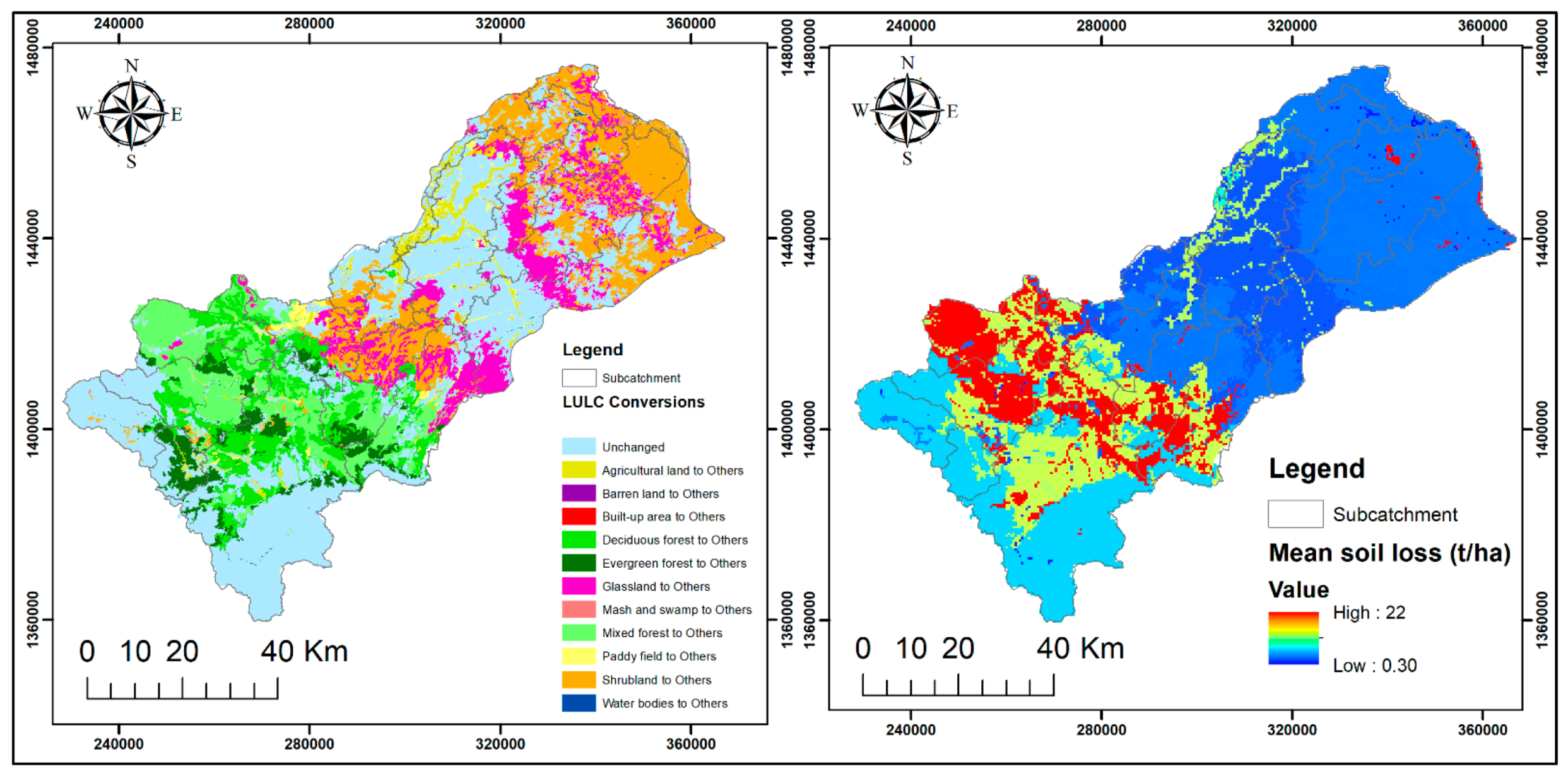
| No | Slope Classes (Degree) | Characteristics | Susceptibility | Area | |
|---|---|---|---|---|---|
| (ha) | (%) | ||||
| 1 | 0–2 | Flat to very gently sloping | Very low | 100,579 | 16.6% |
| 2 | 2–5 | Gently sloping | Low | 212,830 | 35.2% |
| 3 | 5–10 | Sloping | Medium | 171,084 | 28.3% |
| 4 | 10–15 | Strongly sloping | High | 59,375 | 9.8% |
| 5 | 15–30 | Moderately steep | Very high | 55,173 | 9.1% |
| 6 | >30 | Steep | Extremely high | 6129 | 1.0% |
| JICA 2002 | MRC 2015 | Net Change | ||||
|---|---|---|---|---|---|---|
| LULC Classes | Area (ha) | Area (%) | Area (ha) | Area (%) | Area (ha) | Area (%) |
| Agricultural land | 25,627.2 | 4.24 | 152,742.3 | 25.24 | 127,115.0 | 21.00 |
| Barren land | 149.2 | 0.02 | 274.0 | 0.04 | 124.8 | 0.02 |
| Built-up area | 1702.8 | 0.28 | 20,870.1 | 3.45 | 19,167.3 | 3.17 |
| Deciduous forest | 74,524.7 | 12.31 | 24,144.9 | 3.99 | −50,379.8 | −8.32 |
| Evergreen forest | 110,474.4 | 18.26 | 90,338.0 | 14.93 | −20,136.4 | −3.33 |
| Grassland | 79,496.0 | 13.14 | 29,394.2 | 4.86 | −50,101.8 | −8.28 |
| Marsh and swamp | 280.3 | 0.05 | 35.8 | 0.01 | −244.6 | −0.04 |
| Mixed forest | 75,361.5 | 12.45 | 64,710.9 | 10.69 | −10,650.6 | −1.76 |
| Paddy field | 92,784.8 | 15.33 | 144,931.5 | 23.95 | 52,146.7 | 8.62 |
| Shrubland | 141,689.0 | 23.41 | 74,019.0 | 12.23 | −67,670.0 | −11.18 |
| Water bodies | 3080.1 | 0.51 | 3709.4 | 0.61 | 629.3 | 0.10 |
| Total | 605,170.0 | 100.00 | 605,170.0 | 100.0 | ||
| No. | Factors | Resolution | Data Source | Format |
|---|---|---|---|---|
| 1 | R Factor | - | Daily rainfall data (2007–2018) from Ministry of Water Resources and Meteorology in Cambodia (MORWAM). | Raster |
| 2 | K Factor | 1 km | FAO/UNESCO Soil Map of the World database through the Harmonized World Soil Database (HWSD) website [78] | Raster |
| 3 | LS Factor | 30 m | Digital Elevation Model (DEM) from the United States Geological Survey (USGS) website [79] | Raster |
| 4 | C Factor | 30 m | Obtained by assigning weighted C factor values to the LULC based on the literatures [3,9,20,22,73,80,81,82] | Raster |
| 5 | P Factor | 30 m | Obtained by assigning weighted P factor values to the LULC based on the literature as suggested by Yang et al. [81]. | Raster |
| LULC Classes | 1C Factor | 2P Factor | References |
|---|---|---|---|
| Agricultural land | 0.5 | 0.5 | 1,2 [81], 1 [81], 1 [3], 1 [37] |
| Barren land | 0.35 | 1.0 | 1,2 [81], 2 [20], 2 [80], 2 [20], 2 [22], 2 [9] |
| Built-up area | 0.1 | 1.0 | 1,2 [81], 2 [20], 2 [80], 2 [20], 2 [22], 2 [9] |
| Deciduous forest | 0.01 | 1.0 | 1,2 [81], 2 [20], 2 [80], 2 [20], 2 [22], 2 [9] |
| Evergreen forest | 0.001 | 1.0 | 1,2 [81], 2 [20], 2 [80], 2 [20], 2 [22], 2 [9] |
| Grassland | 0.08 | 1.0 | 1,2 [81], 2 [20], 2 [80], 2 [20], 2 [22], 2 [9] |
| Marsh and swamp | 0.05 | 1.0 | 1,2 [81], 2 [20], 2 [80], 2 [20], 2 [22], 2 [9] |
| Mixed forest | 0.1 | 0.8 | 1,2 [81] |
| Paddy field | 0.1 | 0.5 | 1,2 [81], 1 [82], 1 [80], |
| Shrubland | 0.014 | 1.0 | 1,2 [81], 2 [20], 2 [80], 2 [20], 2 [22], 2 [9] |
| Water bodies | 0.01 | 1.0 | 1,2 [81], 2 [20], 2 [80], 2 [20], 2 [22], 2 [9] |
| Station | Location | Elevation (m) | Mean Annual Rainfall (2007–2018) | R Factor (MJ/mm/ha/hr/y) | |
|---|---|---|---|---|---|
| Longitude | Latitude | ||||
| Pailin | 102.6115 | 12.85589 | 95 | 1399.8 | 528.4 |
| Battambang | 103.204 | 13.0989 | 94 | 1318.7 | 500.1 |
| Samlout | 102.8594 | 12.61453 | 153 | 1576.9 | 590.4 |
| Rotanak Mondol | 102.9674 | 12.89267 | 258 | 1313.1 | 498.1 |
| Moung Ruessei | 103.4457 | 12.77753 | 29 | 1308.3 | 496.4 |
| Pursat | 103.5400 | 12.3300 | 22 | 1410.7 | 532.3 |
| Soil Type | Soil Texture | K Factor (t ha h/ha/MJ/mm) | Area (ha) | (%) | References |
|---|---|---|---|---|---|
| Eutric Gleysols (Ge) | Clay | 0.26 | 164,959 | 27% | [81] |
| Gleyic Luvisols (Lg) | Clay Loam | 0.30 | 204,534 | 34% | [81] |
| Dystric Nitosols (Nd) | Clay | 0.26 | 165,639 | 27% | [81] |
| Orthic Acrisols (Ao) | Clay Loam | 0.27 | 70,040 | 12% | [81] |
| Total | 605,170 | 100% |
| Severity Classes | Soil Loss (t/ha/y) | JICA 2002 | MRC 2015 | Net Change (ha) | ||||
|---|---|---|---|---|---|---|---|---|
| Area | Soil Loss (t/ha/y) | Area | Soil Loss (t/ha/y) | |||||
| (ha) | (%) | (ha) | (%) | |||||
| Very low | <2 | 484,089 | 80.0 | 0.2 | 443,439 | 73.3 | 0.2 | −40,650 |
| Low | 2–5 | 52,646 | 8.7 | 3.2 | 50,897 | 8.4 | 3.3 | −1749 |
| Moderate | 5–10 | 28,854 | 4.8 | 7.0 | 33,416 | 5.5 | 7.1 | +4562 |
| Severe | 10–20 | 18,961 | 3.1 | 13.9 | 25,023 | 4.1 | 14.3 | +6062 |
| Very severe | 20–40 | 11,463 | 1.9 | 27.5 | 22,940 | 3.8 | 28.5 | −11,477 |
| Extremely Severe | >40 | 9157 | 1.5 | 60.0 | 29,455 | 4.9 | 62.9 | −20,298 |
| Total Area | 605,170 | 100.0 | 605,170 | 100.0 | ||||
| Severity Classes | Soil Loss (t/ha/y) | JICA 2002 | MRC 2015 | Total Annual Soil Loss | |||||
|---|---|---|---|---|---|---|---|---|---|
| Area | Area | 2002 | 2015 | ||||||
| (ha) | (%) | (ha) | (%) | (tons) | (%) | (tons) | (%) | ||
| Very low | <2 | 484,089 | 80.0 | 443,439 | 73.3 | 104,958 | 6.5 | 77,615 | 2.3 |
| Low | 2–5 | 52,646 | 8.7 | 50,897 | 8.4 | 169,155 | 10.5 | 166,630 | 5.0 |
| Moderate | 5–10 | 28,854 | 4.8 | 33,416 | 5.5 | 201,419 | 12.6 | 237,254 | 7.1 |
| Severe | 10–20 | 18,961 | 3.1 | 25,023 | 4.1 | 263,691 | 16.4 | 357,164 | 10.7 |
| Very severe | 20–40 | 11,463 | 1.9 | 22,940 | 3.8 | 315,430 | 19.7 | 653,124 | 19.5 |
| Extremely Severe | >40 | 9157 | 1.5 | 29,455 | 4.9 | 549,581 | 34.3 | 1,851,429 | 55.4 |
| Total Area | 605,170 | 100.0 | 605,170 | 100.0 | 1,604,234 | 100.0 | 3,343,216 | 100.0 | |
| No | Elevation (Meters) | Area | Erosion (t/ha/y) | Net Change (t/ha/y) | ||
|---|---|---|---|---|---|---|
| (ha) | (%) | 2002 | 2015 | |||
| 1 | 0–300 | 529,855 | 87.6 | 2.7 | 5.2 | 2.5 |
| 2 | 300–600 | 39,347 | 6.5 | 0.8 | 0.9 | 0.1 |
| 3 | 600–900 | 29,454 | 4.8 | 0.4 | 0.3 | −0.1 |
| 4 | 900–1200 | 6065 | 1.0 | 0.9 | 0.7 | −0.3 |
| 5 | 1200–1500 | 449 | 0.1 | 0.4 | 0.4 | 0.0 |
| No | Slope Classes (Degree) | Area | Erosion (t/ha/y) | Net Change (t/ha/y) | ||
|---|---|---|---|---|---|---|
| (ha) | (%) | 2002 | 2015 | |||
| 1 | 0–2 | 100,579 | 16.6% | 0.8 | 1.7 | 0.8 |
| 2 | 2–5 | 212,830 | 35.2% | 1.7 | 3.6 | 1.9 |
| 3 | 5–10 | 171,084 | 28.3% | 3.6 | 9.6 | 6.0 |
| 4 | 10–15 | 59,375 | 9.8% | 6.4 | 17.7 | 11.3 |
| 5 | 15–30 | 55,173 | 9.1% | 7.2 | 16.1 | 8.9 |
| 6 | >30 | 6129 | 1.0% | 16.3 | 27.6 | 11.3 |
| LULC Classes | JICA 2002 | MRC 2015 | ||||
|---|---|---|---|---|---|---|
| Soil Loss (tons) | Area | Soil Loss (tons) | Area | |||
| (ha) | (%) | (ha) | (%) | |||
| Agricultural land | 463,962 (24.6%) | 25,627.2 | 4.24 | 3,757,018 (81.5%) | 152,742.3 | 25.24 |
| Barren land | 1240 (0.1%) | 149.2 | 0.02 | 51,823 (1.2%) | 274.0 | 0.04 |
| Built-up area | 14,748 (0.7%) | 1702.8 | 0.28 | 147,967 (3.2%) | 20,870.1 | 3.45 |
| Deciduous forest | 83,370 (4.4%) | 74,524.7 | 12.31 | 28,244 (0.6%) | 24,144.9 | 3.99 |
| Evergreen forest | 37,189 (1.9%) | 11,0474.4 | 18.26 | 33,443 (0.7%) | 90,338.0 | 14.93 |
| Grassland | 241,922 (12.5%) | 79,496.0 | 13.14 | 49,179 (1.0%) | 29,394.2 | 4.86 |
| Marsh and swamp | 305 (0.1) | 280.3 | 0.05 | 73 (0.1) | 35.8 | 0.01 |
| Mixed forest | 797,562 (41.9%) | 75,361.5 | 12.45 | 129,349 (2.8%) | 64,710.9 | 10.69 |
| Paddy field | 185,115 (9.7%) | 92,784.8 | 15.33 | 234,464 (6.3%) | 144,931.5 | 23.95 |
| Shrubland | 78,143 (4.1%) | 141,689.0 | 23.41 | 106,771 (2.6%) | 74,019.0 | 12.23 |
| Water bodies | 0 | 3080.1 | 0.51 | 0 | 3709.4 | 0.61 |
| Total Area | 1,903,554 | 605,170.0 | 100.0 | 4,538,331 | 605,170.0 | 100.0 |
| No | LULC Categories | Unchanged Area (ha) | Changed Area (ha) | Major LULC Conversions | Changed Area from LULC Categories (ha) | Soil Erosion (t/ha) | Soil Erosion (tons) |
|---|---|---|---|---|---|---|---|
| 1 | Agricultural land | 11,299 | 14,328 | Built-up area | 11,789.30 | 7.2 | 85,319.6 |
| Paddy field | 1371.36 | 3.0 | 4083.8 | ||||
| 2 | Deciduous forest | 20,712 | 53,813 | Agricultural land | 37,911.56 | 23.2 | 878,981.9 |
| Shrubland | 9688.02 | 2.3 | 22,501.6 | ||||
| Evergreen forest | 3583.24 | 0.2 | 611.5 | ||||
| 3 | Evergreen forest | 83,150 | 27,324 | Agricultural land | 19,309.68 | 31.3 | 603,570.1 |
| Shrubland | 6878.94 | 4.8 | 32,931.1 | ||||
| 4 | Grassland | 12,396 | 67,100 | Paddy field | 35,168.84 | 1.9 | 67,545.0 |
| Shrubland | 18,624.00 | 0.5 | 9767.2 | ||||
| Agricultural land | 6348.09 | 18.4 | 117,116.3 | ||||
| 5 | Mixed forest | 1462 | 73,900 | Agricultural land | 57,862.69 | 27.6 | 1,597,728.4 |
| Shrubland | 9621.66 | 3.8 | 36,994.1 | ||||
| 6 | Paddy field | 82,643 | 10,142 | Built-up area | 4777.65 | 5.6 | 26,819.6 |
| Agricultural land | 4114.09 | 15.6 | 64,104.8 | ||||
| 7 | Shrubland | 27,628 | 114,061 | Mixed forest | 56,712.51 | 2.1 | 116,896.8 |
| Paddy field | 23,401.65 | 2.7 | 62,869.5 | ||||
| Grassland | 16,699.67 | 1.8 | 30,334.7 | ||||
| Agricultural land | 14,775.34 | 17.5 | 258,200.8 |
Publisher’s Note: MDPI stays neutral with regard to jurisdictional claims in published maps and institutional affiliations. |
© 2021 by the authors. Licensee MDPI, Basel, Switzerland. This article is an open access article distributed under the terms and conditions of the Creative Commons Attribution (CC BY) license (https://creativecommons.org/licenses/by/4.0/).
Share and Cite
Nut, N.; Mihara, M.; Jeong, J.; Ngo, B.; Sigua, G.; Prasad, P.V.V.; Reyes, M.R. Land Use and Land Cover Changes and Its Impact on Soil Erosion in Stung Sangkae Catchment of Cambodia. Sustainability 2021, 13, 9276. https://doi.org/10.3390/su13169276
Nut N, Mihara M, Jeong J, Ngo B, Sigua G, Prasad PVV, Reyes MR. Land Use and Land Cover Changes and Its Impact on Soil Erosion in Stung Sangkae Catchment of Cambodia. Sustainability. 2021; 13(16):9276. https://doi.org/10.3390/su13169276
Chicago/Turabian StyleNut, Nareth, Machito Mihara, Jaehak Jeong, Bunthan Ngo, Gilbert Sigua, P.V. Vara Prasad, and Manny R. Reyes. 2021. "Land Use and Land Cover Changes and Its Impact on Soil Erosion in Stung Sangkae Catchment of Cambodia" Sustainability 13, no. 16: 9276. https://doi.org/10.3390/su13169276
APA StyleNut, N., Mihara, M., Jeong, J., Ngo, B., Sigua, G., Prasad, P. V. V., & Reyes, M. R. (2021). Land Use and Land Cover Changes and Its Impact on Soil Erosion in Stung Sangkae Catchment of Cambodia. Sustainability, 13(16), 9276. https://doi.org/10.3390/su13169276










